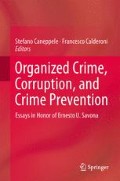Abstract
This chapter applies script analysis to crime controllers. It is argued that examining scripts from the perspective of crime controllers (i.e., handler, capable guardian and place manager) could proved beneficial for preventing complex forms of crime such as organized crimes. Indeed the sequence of actions of handlers, capable guardians and place managers can be scripted for purposes of situational prevention. To illustrate, a hypothetical example of a script for each crime controller is presented. It is concluded that the script approach represents an opportunity to facilitate the supervision and/or intervention process of crime controllers.
To a genuinely warm and generous man
Salute Ernesto!
Access this chapter
Tax calculation will be finalised at checkout
Purchases are for personal use only
References
Brayley, H., Cockbain, E., & Laycock, G. (2011). The value of crime scripting: Deconstructing internal child sex trafficking. Policing, 5, 132–143.
Chiu, Y.-N., Leclerc, B., & Townsley, M. (2011). Crime script analysis of drug manufacturing in clandestine laboratories: Implications for strategic intervention. British Journal of Criminology, 51, 355–374.
Clarke, R. V., & Eck, J. (2005). Crime analysis for problem solvers in 60 small steps. Washington, DC: US Department of Justice Office of Community Oriented Policing Services. www.popcenter.org.
Clarke, R. V., & Newman, G. R. (2006). Outsmarting the Terrorist. Westport CT: Praeger Security International.
Cohen, L. E., & Felson, M. (1979). Social change and crime rate trends: A routine activity approach. American Sociological Review, 44, 588–608.
Cornish, D. B. (1994). The procedural analysis of offending and its relevance for situational prevention. In R. V. Clarke (ed.) Crime Prevention Studies (Vol. 3). Monsey: Criminal Justice Press.
Cornish, D. B., & Clarke, R. V. (2002). Analizing organized crimes. In A. Piquero & S. G. Tibbetts (Eds.), Rational choice and criminal Behavior: Recent research and future challenges. New York: Routledge.
Cornish, D. B., & Clarke, R. V. (2003). Opportunities, precipitators and criminal decisions: A reply to Wortley’s critique of situational crime prevention. In M. Smith & D. B. Cornish (eds.), Crime Prevention Studies: Vol. 16. Theory for practice in situational crime prevention. Monsey: Criminal Justice Press.
Eck, J., & Weisburd, D. (1995). Crime places in crime theory. In J. Eck & D. Weisburd (Eds.), Crime prevention studies: Vol. 4. Crime and place. Monsey: Criminal Justice Press.
Felson, M. (1986). Linking criminal choices, routine activities, informal control, and criminal outcomes. In D. B. Cornish & R. V. Clarke (Eds.), The reasoning criminal: Rational choice approaches on offending. New York: Springer-Verlag.
Felson, M. (1995). Those who discourage crime. In J.E. Eck and D.Weisburd (eds.), Crime Prevention Studies: Vol. 4. Crime and place. Monsey: Criminal Justice Press.
Fiske, S. T., & Taylor, S. E. (1991). Social cognition (2nd ed.). New York: McGraw-Hill.
Hancock, G., & Laycock, G. (2010). Organized crime and crime scripts: prospects for disruption. In K. Bullock, R. V. Clarke, & N. Tilley (eds.), Situational prevention of organized crime. Devon: Willam Publishing.
Hiropoulos, A., Freilich, J., Chermak, S., & Newman, G. (2013). Cigarette smuggling and terrorism financing: A script approach. In B. Leclerc & R. Wortley (eds.), Cognition and crime: Offender decision-making and script analyses. Crime science series. London: Routledge.
Leclerc, B. (2013). New developments in script analysis for situational crime prevention: Moving beyond offender scripts. In B. Leclerc & R. Wortley (eds.), Cognition and crime: Offender decision-making and script analyses. Crime Science Series. London: Routledge.
Leclerc, B., & Reynald, D. (submitted). When scripts and guardianship unite: A script model to facilitate intervention by capable guardians.
Leclerc, B., Wortley, R., & Smallbone, S. (2011). Getting into the script of adult child sex offenders and mapping out situational prevention measures. Journal of Research in Crime and Delinquency, 48, 209–237.
Moreto, W. M., & Clarke, R. V. (2013). Script analysis of the transnational illegal market in endangered species: Dream and reality. In B. Leclerc, & R. Wortley (eds.), Cognition and crime: Offender decision-making and script analyses. Crime Science Series. London, UK: Routledge.
Savona, E. U. (2010). Infiltration by Italian organized crime (Mafia, N’drangheta & Camorra) of the public construction industry. In K. Bullok, R. V. Clarke, & N. Tilley (eds.), Situational prevention of organized crimes. Devon: Willan Publishing.
Savona, E. U., Giommoni, L., & Mancuso, M. (2013). Human trafficking for sexual exploitation in Italy. In B. Leclerc & R. Wortley (eds.), Cognition and crime: Offender decision-making and script analyses. Crime Science Series. London: Routledge.
Schank, R., & Abelson, R. P. (1977). Scripts, plans, goals and understanding: An inquiry into human knowledge. Hillsdale: Erlbaum.
Smith, M. J., & Cornish, D. B. (2006). Secure and tranquil travel: Preventing crime and disorder on public t ransport. United Kingdom: Jill Dando Institute of Crime Science.
Author information
Authors and Affiliations
Corresponding author
Editor information
Editors and Affiliations
Rights and permissions
Copyright information
© 2014 Springer International Publishing Switzerland
About this chapter
Cite this chapter
Leclerc, B. (2014). Script Analysis for Crime Controllers: Extending the Reach of Situational Crime Prevention. In: Caneppele, S., Calderoni, F. (eds) Organized Crime, Corruption and Crime Prevention. Springer, Cham. https://doi.org/10.1007/978-3-319-01839-3_2
Download citation
DOI: https://doi.org/10.1007/978-3-319-01839-3_2
Published:
Publisher Name: Springer, Cham
Print ISBN: 978-3-319-01838-6
Online ISBN: 978-3-319-01839-3
eBook Packages: Humanities, Social Sciences and LawSocial Sciences (R0)

